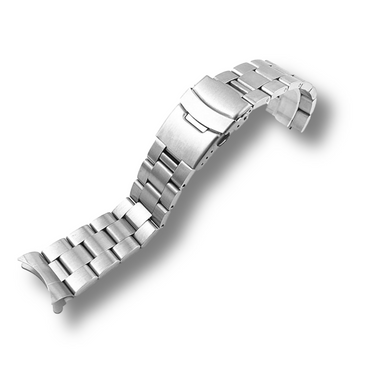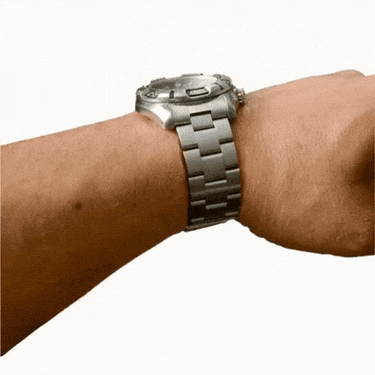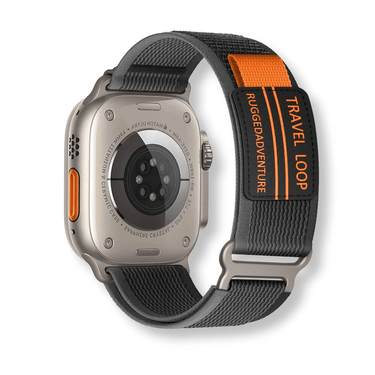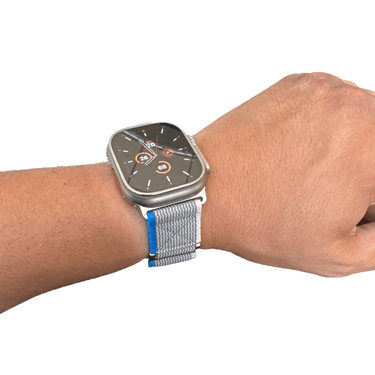Introduction
In the realm of horology, where craftsmanship and precision unite, one crucial element often overlooked is the watch band. As an integral part of any timepiece, the watch band offers more than just a means to secure the watch on one's wrist; it is a reflection of personal style and plays a vital role in enhancing the overall aesthetic appeal.
Each watch band material possesses distinct qualities, presenting consumers with myriad options to consider. This article aims to delve into this fascinating world of watch bands and explore the pros and cons of different materials, ultimately answering the timeless question— which watch band material reigns supreme?
The Importance of Watch Bands
While the primary function of a watch is to tell time with accuracy, its allure lies beyond mere functionality. A well-crafted timepiece can serve as an exquisite expression of one's personality and taste. However, it is the choice of watch band material that truly elevates this accessory from being merely utilitarian to becoming a statement piece.
Aesthetically speaking, the right watch band can transform an ordinary timepiece into a symbol of elegance or sportiness, depending on its design and material. The harmonious combination between case design and strap material often defines whether a watch suits formal occasions or casual settings.
Therefore, selecting an appropriate band material becomes essential in curating an ensemble that embodies both style and sophistication. Beyond aesthetics, comfort plays a pivotal role in determining overall satisfaction with any wristwatch.
A poorly chosen or uncomfortable strap can mar even the most luxurious timepieces' appeal. The ideal strap should seamlessly meld with one's wrist while allowing freedom of movement without causing irritation or discomfort.
Introduce The Main Question: Which Watch Band Material is Best?
Now that we have established why selecting an appropriate watch band material is imperative, it is time to embark on the quest for the ultimate watch band material. With an array of options available—ranging from traditional leather to modern stainless steel and rubber—one may find themselves grappling with a difficult decision. Achieving a comprehensive understanding of the pros and cons of each material will empower consumers to make an informed choice based on their preferences, lifestyle, and specific requirements.
This article will navigate through the merits and drawbacks of three prominent watch band materials: leather, stainless steel, and rubber. By assessing their distinguishing characteristics in terms of aesthetics, comfort, durability, maintenance requirements, and suitability for various activities and occasions, we aim to shed light on which material reigns supreme in the world of watch bands.
Leather Watch Bands
History and Evolution of Leather as a Popular Watch Band Material
Leather watch bands have a rich history that dates back centuries. The use of leather for watch straps can be traced back to the early days of horology when pocket watches were converted into wristwatches. Initially, leather served as a practical solution to securely fasten timepieces to the wrist.
Over time, leather watch bands evolved from being purely functional to becoming fashion statements. As the popularity of wristwatches grew in the early 20th century, so did the demand for aesthetically pleasing watch bands.
Leather quickly became synonymous with elegance and sophistication. One significant breakthrough in the world of leather watch bands was the introduction of genuine calf leather in the mid-20th century.
This type of leather is known for its durability, suppleness, and ability to develop a unique patina over time. The natural characteristics of calf leather made it an ideal choice for high-end watches.
Pros: Classic and Timeless Aesthetic Appeal
One undeniable advantage of leather watch bands is their timeless aesthetic appeal. Leather has an inherent ability to exude elegance and refinement like no other material can. Whether it's a vintage-inspired dress watch or a modern timepiece, a well-crafted leather strap adds an air of class and sophistication to any wrist.
Additionally, leather straps offer versatility with their wide range of colors, textures, and finishes available in the market today. From classic shades like black and brown to more daring options such as blue or burgundy, there is a vast array of choices that cater to various personal styles.
Pros: Comfortable to Wear, Molds to Wrist Over Time
Another advantage that sets leather apart is its exceptional comfort when worn on the wrist. Unlike metal or rubber alternatives that may feel rigid, leather straps gradually mold to the wearer's wrist over time, providing a customized and comfortable fit.
The natural flexibility and suppleness of leather ensure that it conforms to the unique contours of each individual's wrist. This quality makes leather watch bands an excellent choice for those seeking long-term comfort without compromising on style.
Pros: Wide Variety of Colors, Textures, and Finishes Available
Leather watch bands offer an extensive range of options when it comes to colors, textures, and finishes. Whether one prefers a smooth and polished surface or a more rugged texture with visible grain patterns, there is a leather strap available to suit every preference.
Different finishes like matte, glossy, or vintage-inspired distressed looks further enhance the variety available. This versatility allows watch enthusiasts to match their timepieces with different occasions or moods effortlessly.
Pros: Suitable for Both Formal and Casual Occasions
One of the key advantages of leather watch straps is their ability to effortlessly transition from formal to casual settings. Regardless of whether you're attending a black-tie event or going for a relaxed weekend brunch, a well-chosen leather band complements any outfit with its subtle elegance.
Leather has an inherent ability to strike the right balance between formal sophistication and casual versatility. The right combination of color, texture, and finishing allows for seamless integration into various clothing styles while maintaining an understated aura of luxury.
Cons: Prone to Wear and Tear, Requires Regular Maintenance
While leather offers numerous advantages as a watch band material, it does come with some drawbacks that need careful consideration. One notable drawback is its susceptibility to wear and tear over time.
Factors such as exposure to sunlight or moisture can accelerate the deterioration process. To maintain the longevity of a leather strap's appearance and functionality, regular maintenance is essential.
Conditioning creams or oils should be applied periodically not only to prevent cracking or drying out but also to enhance its natural luster. Additionally, leather straps should be kept away from water or excessive moisture as it can cause irreversible damage.
Cons: Not Suitable for High-Intensity Activities or Exposure to Water
Another limitation of leather watch bands is their lack of suitability for high-intensity physical activities or exposure to water. While certain treatments and coatings can render them water-resistant to some extent, leather straps are generally not designed to withstand prolonged contact with moisture.
Engaging in rigorous sports activities or submerging the strap in water may cause deformation, discoloration, or even complete deterioration. Therefore, individuals with an active lifestyle or those who frequently engage in outdoor activities might prefer alternative materials that offer greater durability and resistance to environmental factors.
Stainless Steel Watch Bands
Emergence of stainless steel as a durable and versatile watch band material
Stainless steel has revolutionized the world of watch bands with its remarkable durability and versatility. Originally used for industrial purposes, it gradually made its way into the realm of horology due to its exceptional strength and resistance to scratches and corrosion. The emergence of stainless steel as a popular watch band material can be attributed to its ability to withstand the rigors of daily wear, making it an ideal choice for those seeking longevity in their timepieces.
Pros
One undeniable advantage of stainless steel watch bands is their exceptional durability. The inherent strength of stainless steel ensures that these bands can withstand the tests of time without succumbing to the usual wear and tear experienced by other materials. Moreover, they are highly resistant to scratches, ensuring that your timepiece maintains its pristine appearance even after years of use.
In terms of aesthetics, stainless steel watch bands exude a sleek and modern appeal that complements various watch designs. Whether you prefer a minimalist dress watch or a robust diving companion, a stainless steel band effortlessly enhances the overall look and feel.
Its versatility allows it to seamlessly adapt to any style or occasion. Maintaining stainless steel watch bands is relatively effortless compared to other materials.
A simple wipe with a soft cloth is usually sufficient for cleaning, restoring their lustrous shine. Their resistance to tarnishing makes them ideal for individuals who prefer low-maintenance accessories.
Stainless steel watch bands are especially favored by sports enthusiasts or those who engage in outdoor activities due to their robustness. With such formidable durability, these bands can endure rough conditions without compromising functionality or aesthetics.
Cons
While there are numerous advantages associated with stainless steel watch bands, it's important to consider potential drawbacks as well. One aspect that may pose an inconvenience to some wearers is the weight of stainless steel. The solid and robust nature of the material can make the watch feel heavy on the wrist, causing discomfort during extended wear.
However, manufacturers have made strides in designing lighter stainless steel options to alleviate this concern. Compared to other materials like leather or rubber, stainless steel watch bands offer limited customization options.
While they come in a variety of finishes (such as brushed or polished), there is less room for creative flair or personalization compared to bands made from alternative materials. This may be a consideration for individuals who prioritize uniqueness and individuality in their accessories.
Stainless steel watch bands have gained immense popularity due to their exceptional durability and versatility. With their resistance to scratches and corrosion, these bands ensure that your timepiece remains pristine even after years of use.
Additionally, their sleek appearance complements various watch designs while being relatively easy to clean and maintain. Though they may feel heavier on the wrist than other materials and offer limited customization options, stainless steel watch bands remain an excellent choice for those seeking long-lasting style and functionality.
Rubber Watch Bands
The rise of rubber as a popular alternative watch band material
Rubber watch bands have gained significant popularity in recent years, emerging as a versatile and durable alternative to traditional materials like leather or stainless steel. Initially introduced as a practical option for sports watches, rubber bands have now transcended their utilitarian roots and made their way into the realm of fashion timepieces. This rise in popularity can be attributed to several key factors that make rubber an attractive choice for watch enthusiasts.
Pros:
- Excellent flexibility, provides a comfortable fit for all wrist sizes: Rubber watch bands are known for their exceptional flexibility, allowing them to conform effortlessly to different wrist shapes and sizes. This ensures a snug fit without compromising comfort, making them suitable for daily wear.
- Waterproof and resistant to extreme temperatures: One of the most significant advantages of rubber watch bands is their inherent resistance to water damage.
Unlike leather or fabric straps, rubber bands can withstand exposure to water without deteriorating or losing shape. Additionally, they are also highly resistant to extreme temperatures, making them ideal for outdoor activities in both hot and cold climates.
- Lightweight, ideal for active lifestyles or sports enthusiasts: Rubber watch bands are incredibly lightweight compared to other materials like metal or ceramic. This makes them perfect for individuals with active lifestyles who prefer not to be weighed down by heavier straps during physical activities such as running, hiking, or sports.
- Available in various vibrant colors: Rubber offers an extensive range of color possibilities that add flair and personality to any timepiece it adorns. From bold primary hues to elegant pastels and everything in between, there is a rubber band color option available for every style preference.
Conclusion
In the ongoing debate over watch band materials, rubber clearly establishes itself as a strong contender. Its excellent flexibility, water resistance, lightweight nature, and vibrant color options make it a versatile and appealing choice for a wide range of individuals. Whether you lead an active lifestyle or simply appreciate the comfort and style rubber bands offer, there is no denying their growing popularity in the world of horology.
So why not embrace the modernity and functionality that rubber brings to your wrist? With its numerous advantages and evolving design options, rubber watch bands add a touch of contemporary appeal while ensuring utmost comfort – truly a winning combination for watch enthusiasts worldwide!
























